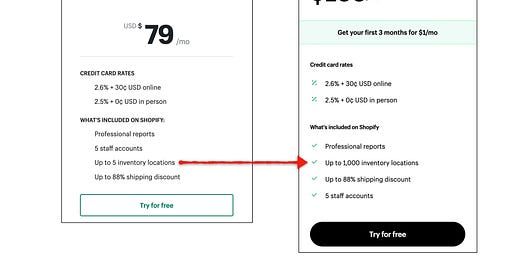Happy Friday, and welcome new subscribers!
These days, most SaaS companies have a usage component to their pricing structure. In my experience, most companies treat these limits with a set it and forget it mentality.
While I don’t think it makes sense to change usage limits regularly, if done right it can be a powerful way to create value for customers, or strengthen your upgrade path. A pricing change is a great time to play around with these limits, and I’ll break down a couple recent examples below.
Before we get there, some of my favorite pricing moves across the SaaS landscape over the past couple weeks 👇🏼
📆 SaaS Pricing Moves
Vendr overhauled its plan assortment, pricing, and positioning.
Eventbrite added a free tier for small events (less than 25 tickets)
Hootsuite offered an alternative to prospects considering a trial — a 30% discount to ‘skip the trial’ altogether.
Vidyard added an AI Script Generator feature to its free plan.
Monte Carlo added specific API call limits to each plan.
PS. I spotted these updates using PricingSaaS. Sign up for free to track competitors, monitor trends, and seed ideas for your own pricing strategy.
Price Change + Usage Limit Update = 🔥
Most SaaS companies don't experiment with their value economics enough. By value economics, I mean the value delivered per dollar in each plan.
This is particularly relevant if you incorporate usage metrics into your pricing. Adjusting value economics simply means either raising or lowering these limits to give customers more or less of that particular metric per dollar spent.
To be clear, this isn’t something you should be flippant about, but there are distinct trigger events where adjusting them make sense. One of which is a price change.
Whether raising or lowering your prices, you can use value economics to benefit either your company or the customer to balance the impact of the move.
👆🏼 Price Increase
When raising prices, adjust value economics to benefit customers. This means offering more value per dollar than before. It will soften the blow for customers, and give you an easy 'win' when messaging the increase.
For example:
When Shopify increased its prices earlier this year, it drastically expanded its inventory limits across all plans. Take the Professional plan as an example:
Before: $79/mo, 5 inventory locations ($15 per inventory location)
After: $105/mo, 1,000 inventory locations (10 cents per inventory location)
To be clear, Shopify had a lot of goodwill going into its pricing change — the company hadn’t meaningfully changed pricing in 12 years. But adding more value gave them an easy way to defend the increase if customers pushed back.
👇🏼 Price Decrease
When lowering prices, you can adjust value economics to benefit your company. This means offering less value per dollar than before.
It allows you to reduce downgrades, and strengthen your upgrade path, while still providing a lower price-point to the customer.
For example:
Apollo.io recently lowered the price of its Basic plan, and decreased the amount of export credits included in the new edition.
Before: $49/mo, 12,000 export credits per year (~20 exports per dollar)
After: $39/mo, 3,000 export credits per year (~6 exports per dollar)
While the price dropped ~20%, the value of a dollar in Apollo credits dropped 70%.
Two reasons this is a smart move:
1. The lower entry-level price point should drive higher free-to-paid conversion.
2. The lower credit limit on Basic should drive more upgrades to Professional.
To reiterate, this isn't the type of thing I'd test frequently — you don't want to drive customers crazy. But I also wouldn't change price points often either, which is why doing both moves in tandem can make a lot of sense.
🔓 Unlock SaaS pricing cheat codes by referring Friends to Good Better Best 🔓
1 referral — The GBB Link Library: A growing list of my go-to SaaS pricing posts and podcasts, organized by topic and format.
3 referrals — PricingSaaS Slack Access: Track pricing changes from the biggest players in SaaS, follow PLG experiments, and more.
5 referrals — Free Pricing Assessment: A 30-minute call where I’ll review your pricing questions and offer feedback and recommendations.






So much of the difficulty in experimenting with price comes down to the implementation challenge. Pricing and packaging logic often ends up stored in a code base. This is a symptom of how entitlements are implemented in applications (hard coded or as feature flags). This drives a ton of complexity into product development.
Part of the complexity is an explosion in customer state, which forces developers to think through a lot of implications related to monetization prior to releasing a feature.
Developers should be able to release features without having to think about customer state and future monetization.
And vice versa, business users should be able to package and price with greater flexibility and less reliance on dev resources.
This is not the case today...
Today a SaaS company can’t issue an offering and have that flow through all systems (CRM, billing, application).
Huge tax on innovation and monetization and underlies a lot of the brittleness related to pricing and packaging...
There are so many conversations and opportunities that businesses simply don’t entertain because they don’t believe they can action the changes in the product